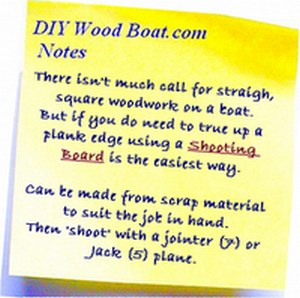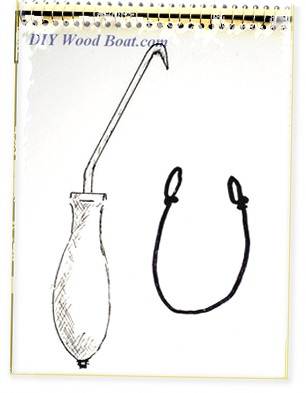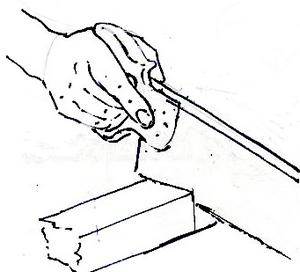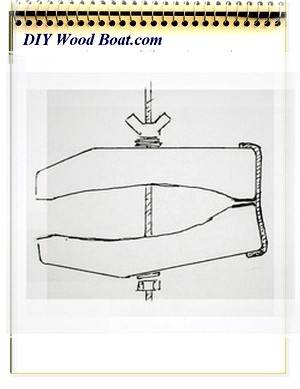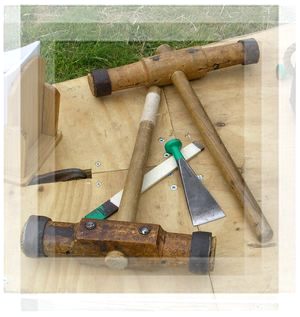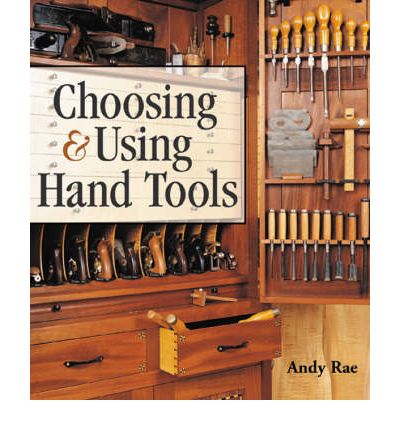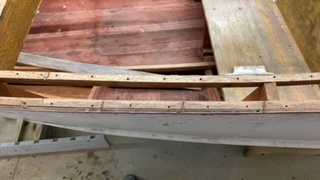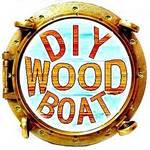- Home
- Boat Building
- Restoration
- Tools
- Bench Planes
- Caulking Irons
- Clamps
- Sharpening
- Tool Care
- Drilling Bits
Drilling Bits and Drills for Wood.
Having the correct drilling bits for the job will help you get your wooden boat project built faster, safer, and with better results.
It is worth having good quality bits.
The cheap, bargain ones rarely remain sharp for long and can be prone to snapping.
Good quality drill bits can be expensive, so it is worth taking care of them.
Drilling Technique for Wood.
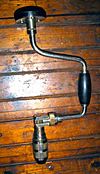
When drilling wood with a power tool remember that it is best to use a slow speed.
Using high speeds will not only scorch the wood but could also burn out the bit.
And don't use the hammer action when drilling wood.
Avoid using too much force especially with small drilling bits, the weight of the drill will be enough to bore the hold without breaking the bit.
To prevent the wood splintering as the bit emerges, clamp a piece of scrap wood to the underneath or stop when the tip emerges and finish off drilling from the other side.
For accurate positioning use a bradawl to mark the starting point.
Keep the bit at a constant angle to the piece.
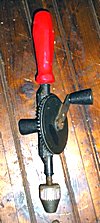
When drilling deep holes, withdraw the bit occasionally to clear the swarf.
A strip of insulating tape wrapped around the bit can be used as a depth gauge.
Keep your bits in a case or box where they cannot roll around causing the edges to be damaged.
And learn how to keep them sharp, a sharp bit will cut better with less effort and produce a cleaner hole.
With power tools becoming cheaper it is unusual for anyone to use a brace and bit or hand cranked drill.
Yet, they do have their place in the boat builder's tool box.
Not only do I find them less hassle to set up for that one off, small hole but I find that they allow me more control for those tricky drilling tasks.
And they are safer to use where there is any water about.
affiliate linksBradawl / Gimlet.
The bradawl is the simplest tool for making small holes.
It doesn't actually remove wood, it simply forces its way between the fibbers.
It is an excellent tool for making starter holes for drilling.
A Gimlet is similar, however it does remove wood so it can be used to make deeper small holes.
affiliate linksTwist drill bits.
These are the most commonly know type of drilling bits.
They are sometimes referred to as twist drills or HSS (high-speed steel) bits.
The most commonly found variety has a shallow point (59degrees) which is primarily meant for drilling metal, they can be used for drilling small holes in wood.
However, when drilling large holes the shallow point can cause them to chip the wood.
Twist bits especially for drilling wood have points angled at 45 degrees, these should not be used for drilling metals.
These bits are cylindrical with two helical flutes spiralling up from the point to allow for chip removal.
They are available with a variety of coatings to increase hardness, abrasion resistance and longer life but these are only effective when drilling metal.
There are various machines and jigs available for sharpening twist drills.
Most folk however simply rotate the point on a grindstone or oil-stone, however it is important to maintain the correct angle of the tip.
affiliate linksLip & spur / Brad-point Bits.
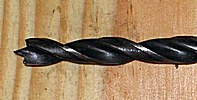
Lip and spur or Brad-point drilling bits are specialist bits for wood drilling.
As with twist drills they are cylindrical with double helical flutes.
However at the business end they have a sharp central point which makes it easier to align the bit precisely.
The cutting edge has two
raised spurs designed to scribe
and cut the outside diameter fast and cleanly.
Normally made from HSS but carbide tipped version while more expensive will remain sharp for longer.
Sharpening needs to be done by hand, the point and spurs can be touched up with a small needle file.
affiliate linksFlat or Spade Drilling Bits.
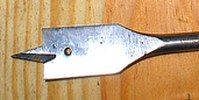
Flat wood bits are designed mainly for use with power drills.
They have two flat cutting edges either side of a center point.
The center point locates the drill while the two angled cutting edges cut the wood leaving a flat bottomed hole.
These can be used to drill fairly large holes, however the larger bits require a fairly powerful drill.
Beware when drilling through as these bits will cause a lot of splintering as they emerge.
HSS, cobalt-coated and carbide-tipped versions are available.
Sharpening can be done with a fine needle file, a grindstone or an oil-stone.
affiliate linksForstner and Spur Bits.
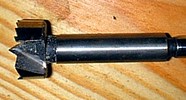
Forstner drilling bits are also specialist wood boring tools.
They have a straight shaft with no flutes.
The cutting head has a very small center point and a cutting spur.
Because of the small centering point they are best used with a power drill held in a drill stand.
They can be used with hand drills, it's just that positioning can be difficult to control.
They are designed primarily for cutting out flat-bottomed holes with very smooth sides.
Because of the way they cut along the outer edge they can be used at an angle to cut arcs and drilling pockets.
Spur drilling bits are basically the same except that they have more cutting teeth which, speeds up cutting with less heat, making them better for cutting larger holes..
As with most other woodworking drills, they are both available in HSS, carbide-tipped and titanium-coated versions.
They can be sharpened with a fine needle file or on an oil-stone.
affiliate linksAuger Bits.
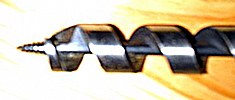
Auger drilling bits have a threaded, screw, center point that draws the bit into the wood.
Because of this be very, very careful if using them with a power drill, they are best used only with a brace.
As the threaded center draws the bit into the wood the single spur (some patterns have double) cuts the outer edge of the hole while counter cutting edge removes the waste.
The helical flutes help keep it on line and bring the waste to the surface.
Their fast action makes them ideal for drilling large diameter, deep flat bottomed holes.
Sharpen these drilling bits with a fine needle file or with an oil-stone.affiliate links
Deep-drilling Bits.
Twist drill bits, augur, and lip and spur drilling bits can all be had in long versions for drilling deep holes.
Bit extensions are also available for most types of drilling bits to allow them to drill deeper.
Expansive Bits.
These bits have an adjustable spur allowing one bit to cut a variety of different diameter holes.
They are however relatively fragile and care must be take when using them, beware of the cheap ones, .
It is probably more economical to buy a full set of normal bits.
Multi Angle / Drill Saw Rasps.
These drilling bits drill down like normal bits but can also cut sideways.
Ideal for rapidly removing wood from slots and such like.
Countersink.
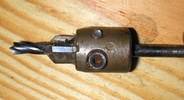
Countersinks come in all shapes and sizes from those that are hand held to fully adjustable drill bits which will drill a pilot hole and counter-bore at the same time.
For best results drill the countersink first, doing it after the hole has been drilled can cause the countersink bit to chatter.
Sharpening can be done with a fine triangular needle file but it is not easy.
affiliate linksHole saw.
Not really a drill as such the hole saw is a cylindrical saw blade fitted to an arbor so they can be used with a power drill.
They are used to cut large diameter holes in wood.
Normally the arbor will have a centering drill bit.
They are best used at low speed in a power drill.
They can be sharpened in the same way as you would sharpen a normal saw with a file and tooth setter.
affiliate linksPlug Cutters.
These
are specially
designed,
believe it or not, for
cutting out wooden plugs.
One
of the problems that arise when plugging is that the
holes, no matter how carefully you drill can vary slightly in size.
So, when looking for a plug cutter, look for the ones which cut either a bevel on one end or a slightly tapered plug.
Plug cutters for obvious reasons do not have a centering spur so they should be used with the drill on a drill stand.
They can be bought in combination with matching lip and drill bits.
affiliate linksPower Drills.
Although I am a great advocate for using hand tools including hand cranked drills and braces, I still wouldn't be without my power drill.
When
buying a drill
consider
the type and amount of work
you will be doing with it.
The old saying "you get what you pay for" is true for drills as with drilling bits or anyything else for that matter.
Buying a good quality drill, with sufficient power for the jobs you intend to do, will save time and cash in the long run.
For general woodworking a drill with a motor in the 550 to 900 watt power range should be adequate.
And we no longer have to be
tied to a power
outlet.
Battery operated cordless drills are extremely versatile.
Their power is dependent on the battery size which, ranges from 9 volts up to as much as 24 volts.
It is worth having two batteries, so as one discharges the other can be clipped in and the first put on charge.
affiliate linksNATIVE ASYNC

